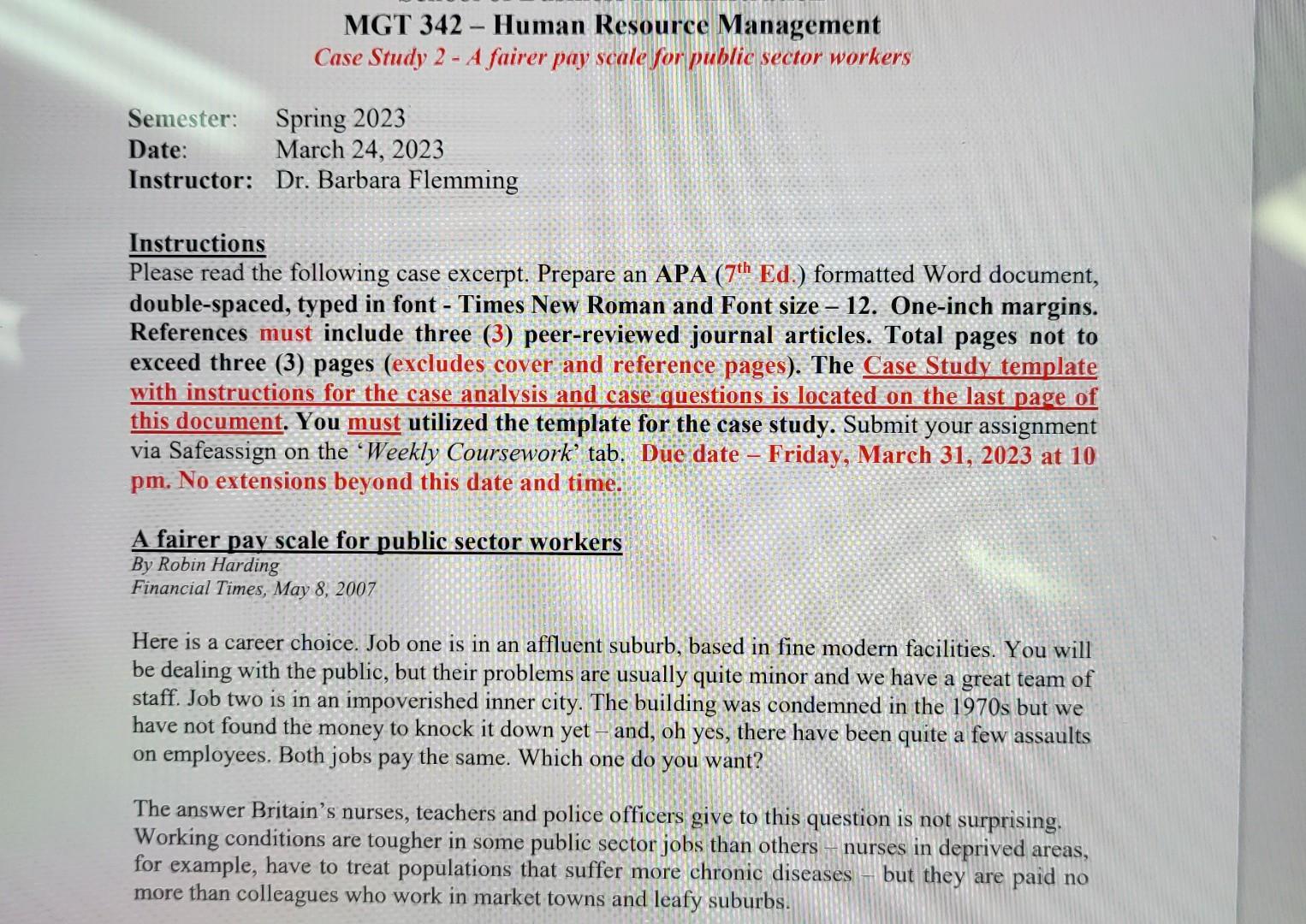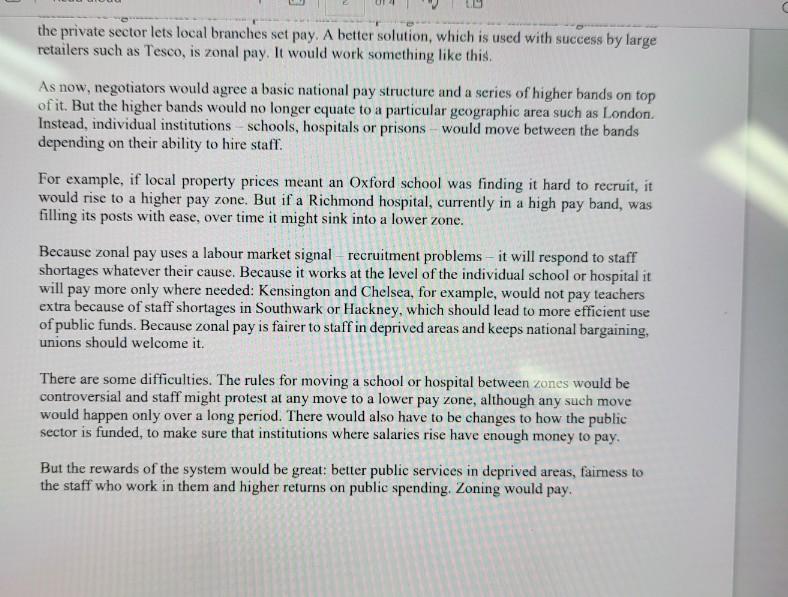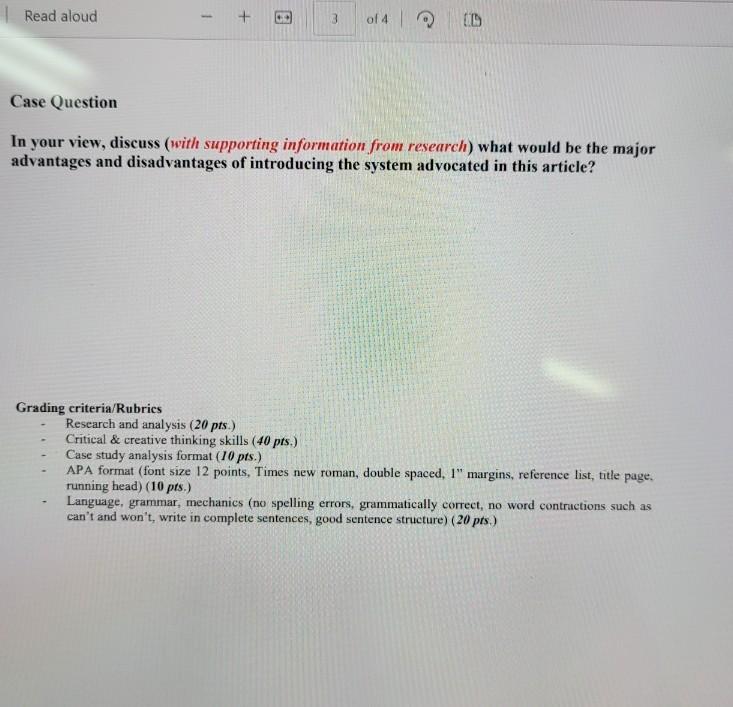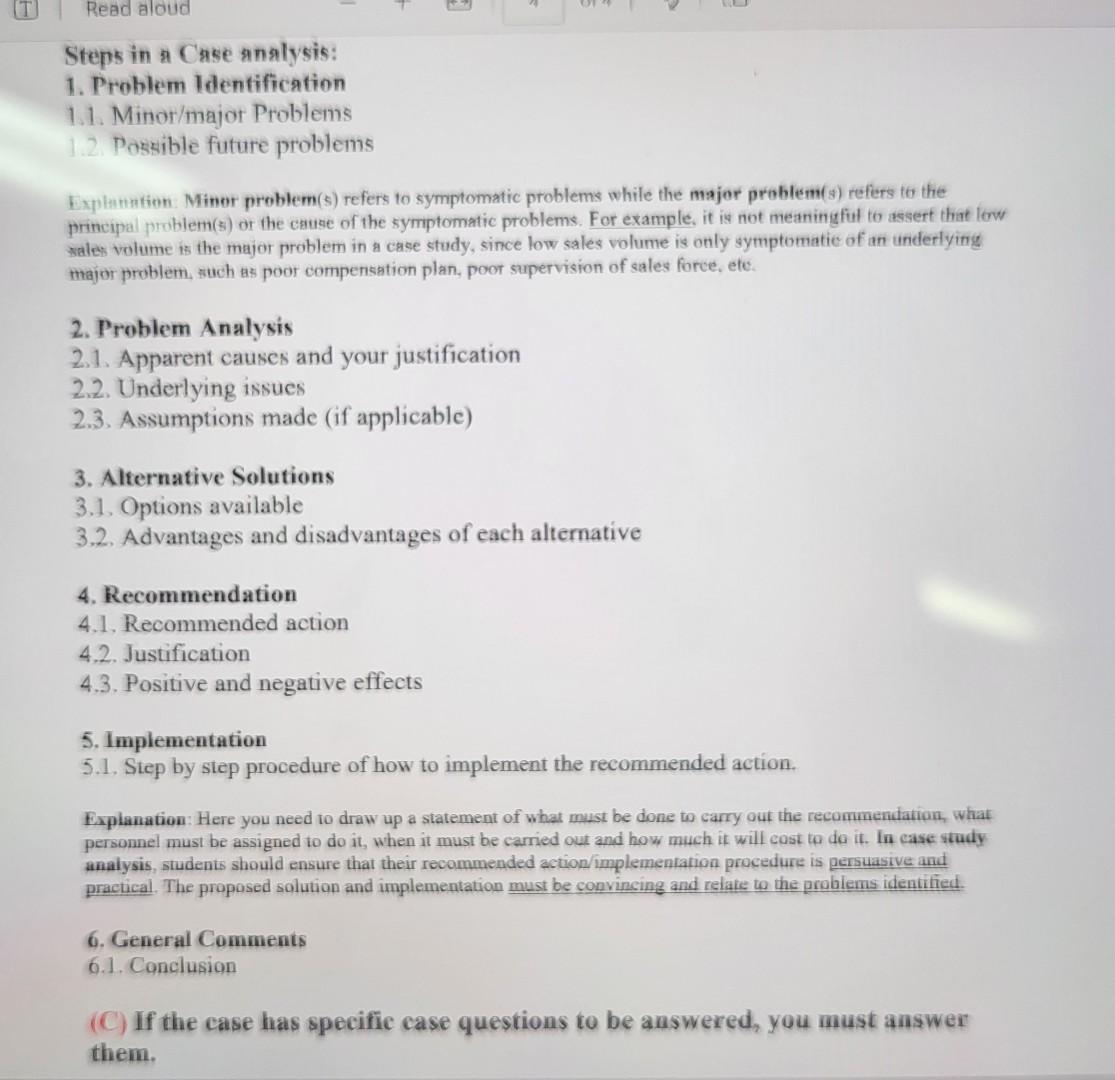Answered step by step
Verified Expert Solution
Question
1 Approved Answer
MGT 342 - Human Resource Management Case Study 2 - A fairer pay scale for public sector workers Semester: Spring 2023 Date: March 24, 2023





MGT 342 - Human Resource Management Case Study 2 - A fairer pay scale for public sector workers Semester: Spring 2023 Date: March 24, 2023 Instructor: Dr. Barbara Flemming Instructions Please read the following case excerpt. Prepare an APA ( 7th Ed.) formatted Word document, double-spaced, typed in font - Times New Roman and Font size - 12. One-inch margins. References must include three (3) peer-reviewed journal articles. Total pages not to exceed three (3) pages (excludes cover and reference pages). The Case Study template with instructions for the case analvsis and case questions is located on the last page of this document. You must utilized the template for the case study. Submit your assignment via Safeassign on the 'Weekly Coursework' tab, Due date - Friday, March 31, 2023 at 10 pm. No extensions beyond this date and time. A fairer pay scale for public sector workers By Robin Harding Financial Times, May 8, 2007 Here is a career choice. Job one is in an affluent suburb, based in fine modern facilities. You will be dealing with the public, but their problems are usually quite minor and we have a great team of staff. Job two is in an impoverished inner city. The building was condemned in the 1970 s but we have not found the money to knock it down yet - and, oh yes, there have been quite a few assaults on employees. Both jobs pay the same. Which one do you want? The answer Britain's nurses, teachers and police officers give to this question is not surprising. Working conditions are tougher in some public sector jobs than others - nurses in deprived areas, for example, have to treat populations that suffer more chronic diseases - but they are paid no more than colleagues who work in market towns and leafy suburbs. The result is staff shortages, rapid staff turnover and lower-quality public services in exactly the areas of greatest need. The solution, proposed in a report published today by the Social Market Foundation, may be a system of zonal pay such as that used by some companies in the private sector. Public sector pay in Britain is negotiated nationally and the rates are the same everywhere, except for crude adjustments to reflect the cost of living in London and the south east. A newly qualified teacher, for example, is paid 19,641 across England and Wales, about 3,000 extra in outer London and a further 1,000 in central London. But these areas of higher pay are defined by lines on a map and, as colonial administrators discovered when drawing the borders of new, independent countries, lines on a map often bear little relation to reality on the ground. A teacher in a southern town such as Ox ford, for example, faces high property prices but earns no more than a teacher in Durham. A nurse living in west London can choose between jobs that pay the same in boroughs such as Richmond, Hounslow and Hillingdon, but Hounslow and Hillingdon are poorer and their staff vacancy rates tend to be higher. In general, vacancy rates vary far more within regions than between them, which suggests that local differences in working conditions and the cost of living are the biggest cause of staff shortages. What is needed is a way to include local labour market signals in public sector pay. Individual schools or hospitals could be given complete flexibility to set pay, but that would tend to be bureaucratic, as thousands of pay negotiations replaced one, and inflationary, as staff benchmarked themselves against whoever was paid best and bid up wages. Almost no national organisation in the private sector lets local branches set pay. A better solution, which is used with success by large retailers such as Tesco, is zonal pay. It would work something like this. As now, negotiators would agree a basic national pay structure and a series of higher bands on fop of it. But the higher bands would no longer equate to a particular geographic area such as London. Instead, individual institutions - schools, hospitals or prisons - would move between the bands depending on their ability to hire staff. For example, if local property prices meant an Oxford school was finding it hard to recruit, it would rise to a higher pay zone. But if a Richmond hospital, currently in a high pay band, was filling its posts with ease, over time it might sink into a lower zone. Because zonal pay uses a labour market signal - recruitment problems - it will respond to staff shortages whatever their cause. Because it works at the level of the individual school or hospital it will pay more only where needed: Kensington and Chelsea, for example, would not pay teachers extra because of staff shortages in Southwark or Hackney, which should lead to more efficient use of public funds. Because zonal pay is fairer to staff in deprived areas and keeps national bargaining, unions should welcome it. There are some difficulties. The rules for moving a school or hospital between zones would be controversial and staff might protest at any move to a lower pay zone, although any such move would happen only over a long period. There would also have to be changes to how the public sector is funded, to make sure that institutions where salaries rise have enough money to pay. But the rewards of the system would be great: better public services in deprived areas, fairness to the staff who work in them and higher returns on public spending. Zoning would pay. Case Question In your view, discuss (with supporting information from research) what would be the major advantages and disadvantages of introducing the system advocated in this article? Grading criteria/Rubrics - Research and analysis ( 20 pts.) - Critical \& creative thinking skills ( 40 pts.) - Case study analysis format ( 10pts.) - APA format (font size 12 points, Times new roman, double spaced, 1" margins, reference list, title page, running head) (10 pts.) - Language, grammar, mechanics (no spelling errors, grammatically correct, no word contractions such as can't and won't, write in complete sentences, good sentence structure) (20 pts.) Steps in a Case analysis: 1. Problem Identification 1.1. Minor/major Problems 1.2. Passible future problems Explanntion. Minor problem(s) refers to symptomatic problems while the major problem(s) refers to the principal problem(s) or the cause of the symiptomatic problems. For example, it is not meaningfut to assert that low sales volume is the major problem in a case study, since low sales volume is only symptomatic of an underlying major problem, such as poor compensation plan, poor supervision of sales force, ete. 2. Problem Analysis 2.1. Apparent causes and your justification 2.2. Underlying issues 2.3. Assumptions made (if applicable) 3. Alternative Solutions 3.1. Options available 3.2. Advantages and disadvantages of each alternative 4. Recommendation 4.1. Recommended action 4.2. Justification 4.3. Positive and negative effects 5. Implementation 5.1. Step by step procedure of how to implement the recommended action. Explanation: Here you need to draw up a statement of what must be done to carry out the recommendation, what persomnel must be assigned to do it, when it must be carried out and how much it will cost to do it. In case study analysis, students should ensure that their recommended action/implementation procedure is persuasive and practical. The proposed solution and implementation must be convincing and relate to the problems identified. 6. General Comments 6.1. Conclusion (C) If the case has specific case questions to be answered, you must answer them
Step by Step Solution
There are 3 Steps involved in it
Step: 1

Get Instant Access to Expert-Tailored Solutions
See step-by-step solutions with expert insights and AI powered tools for academic success
Step: 2

Step: 3

Ace Your Homework with AI
Get the answers you need in no time with our AI-driven, step-by-step assistance
Get Started


